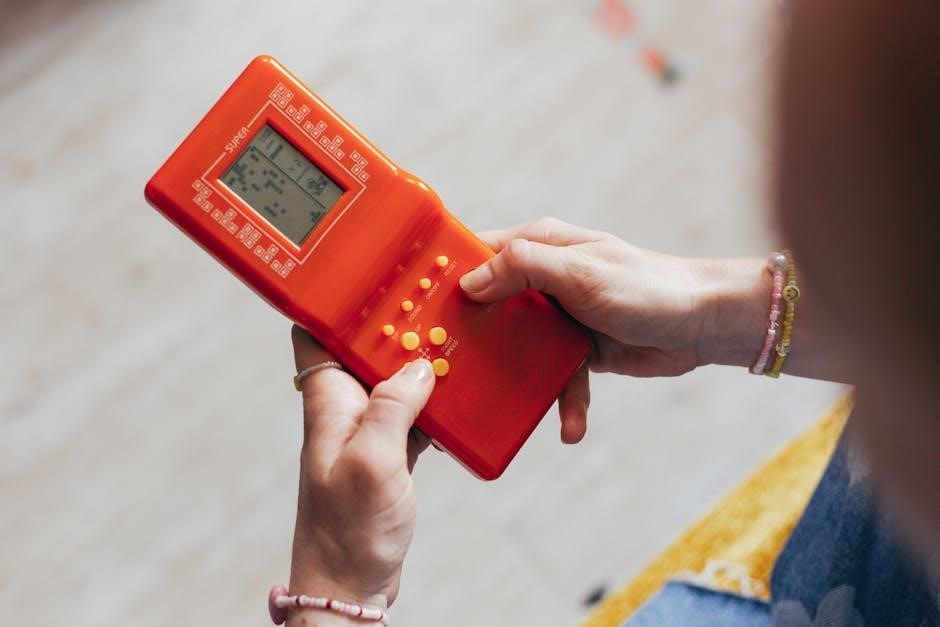poulan pro pr4218 manual
Poulan Pro PR4218 Manual: A Comprehensive Guide
This official instruction manual provides detailed guidance for operating and maintaining the Poulan Pro PR4218 chainsaw. Careless use can lead to serious injury; read the manual before operation.
Discover features, functionality, and essential maintenance procedures within this comprehensive guide, ensuring successful and safe operation of your new tool.
Welcome! This manual serves as your partner for successfully utilizing the Poulan Pro PR4218 chainsaw. Before initial use, thoroughly familiarize yourself with its features and functionalities. Understanding this chainsaw’s capabilities ensures optimal performance and longevity.
This guide details safe operation, proper maintenance, and troubleshooting steps. Remember, reading and understanding this instruction manual is crucial to prevent serious injury. Join the community and unlock the full potential of your new tool!
Safety Precautions & Warnings
Serious injury can result from careless or improper chainsaw use. Always prioritize safety! Read and understand this entire manual before operating the Poulan Pro PR4218. Never attempt to throw or drop-start the chainsaw – this is extremely dangerous.
Ensure all repairs and adjustments not detailed in this manual are performed by qualified service personnel. Always be aware of your surroundings and potential hazards while operating this powerful tool.
Understanding the Chainsaw Components

Familiarizing yourself with the Poulan Pro PR4218’s parts is crucial for safe operation and maintenance. This section details key components, enabling effective troubleshooting and upkeep. Understanding the chain and bar specifications ensures optimal cutting performance and longevity.
Proper identification of each part allows for informed repairs and adjustments, maximizing the chainsaw’s efficiency and minimizing potential issues during use.
Identifying Key Parts
Key parts of the Poulan Pro PR4218 include the engine, chain brake, throttle control, starter assembly, and anti-vibration system. The bar and chain are essential cutting components, while the sprocket facilitates chain movement.
Locate the fuel tank, oil reservoir, and air filter for proper fueling and maintenance. Understanding each part’s function is vital for safe operation and effective repairs, as outlined in the manual.
Chain and Bar Specifications
The Poulan Pro PR4218 typically utilizes a 16-inch or 18-inch bar, with a corresponding chain pitch of 3/8 inch. Chain gauge is commonly .050 inches. Proper chain tension and bar maintenance are crucial for optimal performance.
Refer to the owner’s manual for specific bar and chain combinations compatible with your model, ensuring safe and efficient cutting operations. Incorrect specifications can damage the chainsaw.

Assembly Instructions
Before initial use, careful assembly is required. This includes securely attaching the chain and bar, ensuring proper alignment and tension. Next, install the handle and verify the chain brake functions correctly.
Consult the owner’s manual for detailed diagrams and step-by-step instructions. Improper assembly can lead to unsafe operation and potential damage to the chainsaw. Always double-check all connections.
Attaching the Chain and Bar
Begin by positioning the bar, ensuring the drive sprocket engages the chain correctly. Carefully place the chain around the bar, aligning the drive links with the bar’s teeth. Secure the bar with the bar nuts, but don’t fully tighten them yet.
Refer to the manual for specific diagrams. Proper chain and bar attachment is crucial for safe and efficient operation; incorrect installation can cause chain derailment.
Handle and Chain Brake Installation
Securely attach the handle to the chainsaw body using the provided bolts, ensuring a firm grip. Next, install the chain brake, verifying it engages and disengages smoothly. The chain brake is a vital safety feature, preventing accidental chain movement.
Consult the owner’s manual for detailed diagrams and torque specifications. Proper installation of both handle and brake is essential for operator control and safety.
Fueling and Mixing
Always use a 50:1 fuel mixture of fresh seasonal gasoline and full synthetic 2-cycle oil. Precisely mix 2.6 ounces of oil per gallon of gasoline, shaking thoroughly before pouring into the fuel tank. Caution: avoid using automotive oil, as it can damage the engine.
Fueling should occur in a well-ventilated area, away from open flames. Wipe up any spills immediately to prevent fire hazards. Refer to the manual for detailed safety guidelines.
Recommended Fuel Mixture (50:1)
Optimal performance of your Poulan Pro PR4218 demands a precise 50:1 fuel-to-oil ratio. This translates to 2.6 ounces of high-quality, full synthetic 2-cycle oil blended with one gallon of fresh, seasonal gasoline. Thoroughly shake the mixture to ensure complete homogenization before adding it to the fuel tank.

Using the correct ratio is crucial for engine longevity and preventing damage.
Fueling Procedures & Safety
Always fuel the Poulan Pro PR4218 in a well-ventilated area, away from open flames or sparks. Ensure the chainsaw is switched off and cool before refueling. Carefully remove the fuel cap and add the pre-mixed 50:1 fuel. Avoid overfilling the tank, leaving space for expansion.

Wipe up any spills immediately and securely replace the fuel cap. Never smoke while fueling.
Starting the Chainsaw
Before starting, ensure the chain brake is engaged and the chainsaw is placed on a firm, level surface. Follow the cold start procedure by setting the choke, priming the fuel bulb, and pulling the starter cord firmly. For a warm start, disengage the choke.
Never attempt to drop or throw start the chainsaw; this is extremely dangerous.
Cold Start Procedure
Begin by engaging the chain brake for safety. Set the choke lever to the “full choke” position. Prime the fuel bulb approximately six to ten times until fuel is visible. Position your foot firmly on the rear handle and grasp the starter handle. Pull the starter cord with a smooth, firm motion.
Repeat until the engine starts, then disengage the choke.
Warm Start Procedure
Ensure the chain brake is engaged for safety. With a warm engine, set the choke lever to the “half choke” or open position. Prime the fuel bulb a few times – typically three to five pumps are sufficient. Firmly plant your foot on the rear handle and grip the starter handle securely.
Pull the starter cord smoothly until the engine restarts.
Operating Instructions
Always maintain a firm grip with both hands while operating the Poulan Pro PR4218. Be acutely aware of kickback potential, a dangerous reaction that can occur when the guide bar’s tip contacts an object. Employ proper cutting techniques, avoiding plunging cuts.
Ensure a clear work area, free from obstructions, and always plan your escape route. Never overreach or cut above shoulder height for optimal control and safety.
Proper Cutting Techniques

When using the Poulan Pro PR4218, utilize a firm stance and maintain a secure grip. Begin by opening the cut with a controlled plunge, then utilize the saw’s weight to assist in the cutting process. Avoid forcing the blade, letting the chain do the work.
Always plan your felling direction and be mindful of branches that may spring back. Use bore-cutting for limbing, and avoid twisting the bar within the cut.
Avoiding Kickback
Kickback, a sudden, forceful upward or backward motion, is dangerous. To minimize risk with your Poulan Pro PR4218, avoid contact between the guide bar’s upper quadrant and any object. Maintain a firm grip with both hands, and never overreach.
Always keep the chain properly sharpened and tensioned. Be acutely aware of the bar’s position during cutting, and never cut above shoulder height.
Chain Sharpening and Maintenance
Maintaining a sharp chain is crucial for safe and efficient operation of your Poulan Pro PR4218. Regularly sharpen the chain to ensure clean cuts and reduce strain on the engine; Inspect the chain for damage, replacing it if necessary.
Consistent sharpening and proper tension contribute to optimal performance and minimize the risk of kickback. Refer to the manual for detailed sharpening instructions and tensioning guidelines.
Sharpening the Chain
To sharpen the chain, use a round file of the correct size, guided by a sharpening tool. Maintain the correct filing angle, ensuring each tooth is sharpened uniformly. File from the inside of the tooth outward, using smooth, consistent strokes.
Check the depth gauges and file them down if needed, maintaining proper height for optimal cutting performance. A properly sharpened chain significantly improves cutting efficiency and safety.
Checking Chain Tension
Proper chain tension is crucial for safe and efficient operation. With the engine off, pull the chain away from the bar; it should lift slightly, approximately 1/8 inch. Adjust tension using the tensioning screw, ensuring the chain moves freely around the bar.
Regularly check tension, especially during initial use, as a new chain stretches. Incorrect tension can lead to derailment or damage to the chainsaw.
Bar Maintenance and Care
Regular bar maintenance extends its lifespan and ensures optimal cutting performance. Frequently clean the bar with a soft cloth, removing sawdust and debris after each use. Inspect the bar rails for wear and burrs; file them smooth if necessary.
Maintain proper lubrication and periodically check for bending or damage. A well-maintained bar contributes significantly to chainsaw safety and efficiency.
Cleaning the Bar
Regularly cleaning the chainsaw bar is crucial for smooth operation and longevity. After each use, utilize a soft cloth to meticulously remove accumulated sawdust, pitch, and wood debris. Pay close attention to the bar’s groove, ensuring it remains free from obstructions.
A clean bar facilitates proper chain lubrication and reduces wear, contributing to efficient cutting and overall chainsaw health.
Bar Rail Maintenance
Maintaining the bar rails is essential for optimal chainsaw performance. Regularly inspect the rails for burrs or damage, as these can cause chain binding and increased wear. Use a flat file to carefully remove any burrs, ensuring smooth, even rails.
Properly maintained rails promote efficient chain travel, reducing friction and extending both bar and chain life, ultimately improving cutting efficiency.
Troubleshooting Common Issues
Encountering problems? If your chainsaw won’t start, check fuel levels, spark plug condition, and ensure the chain brake is disengaged. A chain running at idle often indicates carburetor issues; refer to the carburetor adjustment section.
Avoid attempting unsafe starting methods like dropping or throwing the chainsaw. Always consult this manual for detailed solutions before seeking professional repair services.
Chainsaw Won’t Start
If the engine fails to ignite, first verify adequate fuel in the tank and a proper 50:1 fuel mixture. Inspect the spark plug for fouling or damage, cleaning or replacing it as needed. Ensure the chain brake is fully disengaged.
Confirm proper flooding isn’t occurring; excessive fuel can hinder starting. Consult the carburetor adjustment section if issues persist.
Chain Runs at Idle
If the chain unexpectedly moves when the engine is idling, immediately stop the chainsaw and disconnect the spark plug wire for safety. This indicates a carburetor issue requiring adjustment. Refer to the CARBURETOR ADJUSTMENT section within this manual for detailed instructions.
Do not attempt to throw or drop-start the chainsaw, as this is extremely dangerous and can cause severe injury.
Carburetor Adjustment
Proper carburetor adjustment is crucial for optimal engine performance. All repairs and adjustments not detailed in the Operator’s Manual must be performed by qualified service personnel. Adjustments impact idle speed and mixture, affecting cutting efficiency and fuel consumption.
Consult the manual for specific procedures regarding adjusting the carburetor and achieving the correct idle speed for your Poulan Pro PR4218 chainsaw.
Adjusting the Carburetor
Carburetor adjustment impacts engine performance, requiring qualified personnel for repairs beyond the Operator’s Manual. Fine-tuning ensures efficient cutting and fuel use. Improper settings can cause starting issues or poor operation. Refer to the manual for detailed steps.

Adjustments affect the air-fuel mixture, influencing idle speed and overall responsiveness. Precise calibration is vital for optimal chainsaw functionality and longevity.
Idle Speed Adjustment
Idle speed adjustment is crucial for smooth chainsaw operation. If the chain runs at idle, refer to the carburetor adjustment section within this manual for corrective actions. Proper idle prevents unwanted chain movement and ensures safe starting and stopping.
Adjusting the idle screw controls the engine’s speed when the throttle is released, maintaining control and preventing accidental cutting.

Chain Brake Function and Maintenance
The chain brake is a vital safety feature, instantly stopping the chain in case of kickback. Regular testing ensures proper functionality; engage the brake before each use. Maintenance involves cleaning and inspecting the brake band and spring for wear or damage.
Properly functioning brakes significantly reduce the risk of injury during operation, safeguarding the user from potential hazards.
Testing the Chain Brake

Before each use, firmly engage the chain brake lever. With the chainsaw running at idle, quickly accelerate the throttle. The chain should not move. If the chain continues to rotate, the brake requires immediate attention and should not be used until repaired.
Consistent testing confirms the brake’s reliability, protecting you from potential kickback injuries during operation. Prioritize safety with this simple check.
Chain Brake Maintenance
Regularly inspect the chain brake for proper function. Ensure the brake lever engages and disengages smoothly. Clean the brake band and surrounding area, removing debris like sawdust and oil. A dirty brake can hinder performance.
If the brake feels sticky or doesn’t hold firmly, consult a qualified service technician. All repairs beyond basic cleaning should be performed by professionals.
Storage and Transport
For long-term storage, drain the fuel tank completely and run the engine until it stalls to empty the carburetor. Clean the chainsaw thoroughly and store it in a dry location. When transporting, always engage the chain brake and use a scabbard.
Safe transport guidelines dictate securing the chainsaw to prevent accidental activation or injury. Follow all local regulations regarding chainsaw transport.
Long-Term Storage Procedures
Prior to extended storage, completely drain the fuel tank to prevent carburetor issues. Run the engine until it stops to ensure it’s fuel-free. Thoroughly clean the chainsaw, removing debris and residue. Store in a dry, secure location, away from children.
Consider applying a light coat of oil to metal surfaces to inhibit rust. Disconnect the spark plug wire for added safety during storage.
Safe Transport Guidelines
Always engage the chain brake and ensure the engine is completely cooled before transporting the Poulan Pro PR4218. Utilize the bar scabbard to protect the chain and prevent accidental contact. Secure the chainsaw properly in a vehicle to avoid shifting during transit.
Never transport a running chainsaw. Follow all local regulations regarding chainsaw transport, prioritizing safety for yourself and others.
Obtaining Replacement Parts & Manuals
Replacement parts and additional owner’s manuals, including a downloadable PDF version, are readily available. Locate authorized Poulan Pro dealers or visit online parts retailers for components. Ensure correct part numbers for compatibility.
Access the complete instruction manual online for detailed diagrams and troubleshooting. All repairs beyond the operator’s manual require qualified service personnel.
Where to Find Parts
Authorized Poulan Pro dealers are the primary source for genuine replacement parts, ensuring compatibility and quality. Numerous online parts retailers also stock components for the PR4218. When ordering, always verify the correct part number to avoid issues.
Confirm specifications before purchase, and consider local hardware stores for common items. Prioritize genuine parts for optimal chainsaw performance and longevity.
Downloading the Owner’s Manual (PDF)
A free copy of the owner’s manual is readily available for download in PDF format. This digital version provides convenient access to all operating instructions and maintenance schedules. Easily store it on your devices for quick reference during use or repairs.

Access the downloadable manual to ensure safe and efficient operation of your Poulan Pro PR4218 chainsaw, anytime, anywhere.


























































































